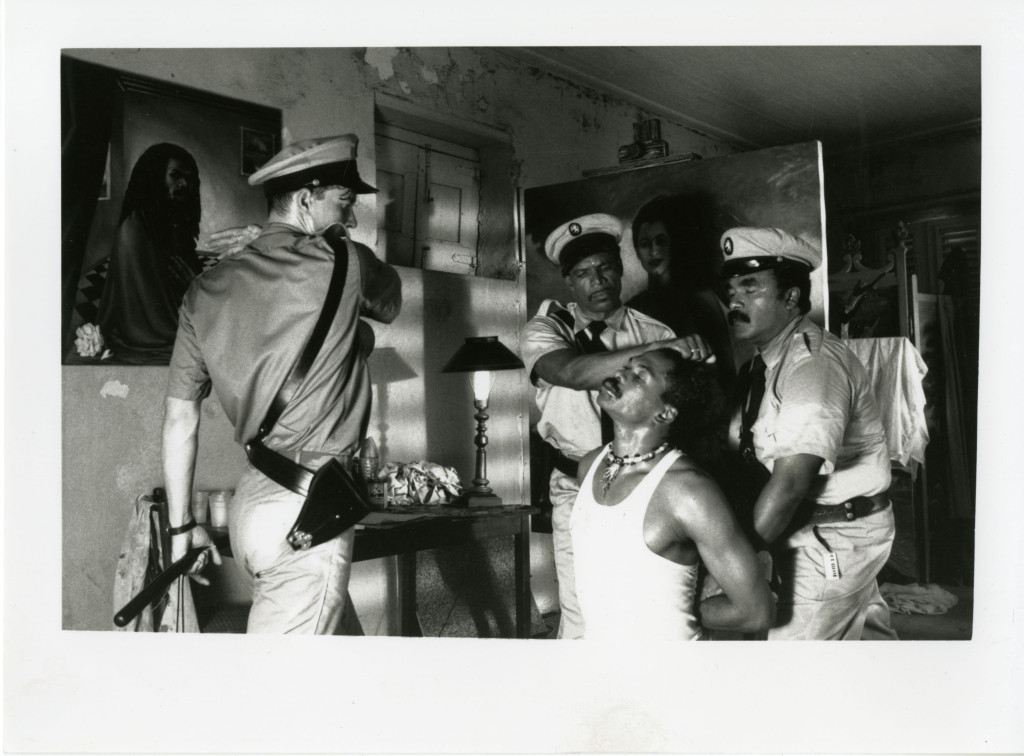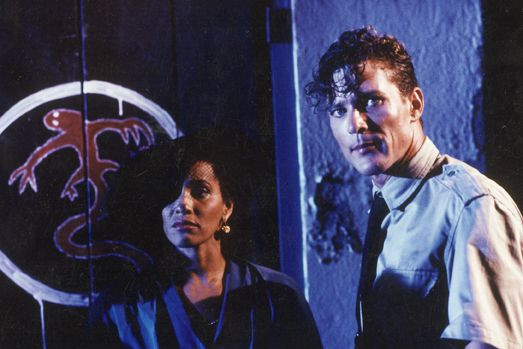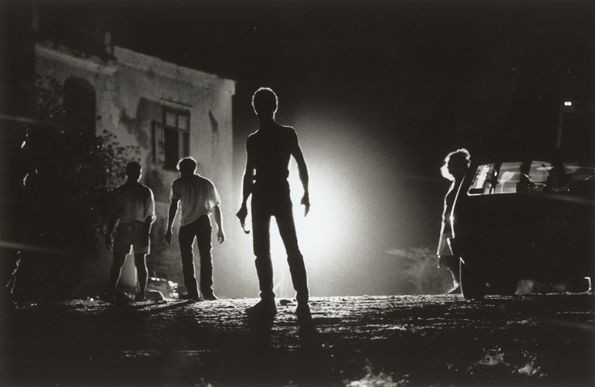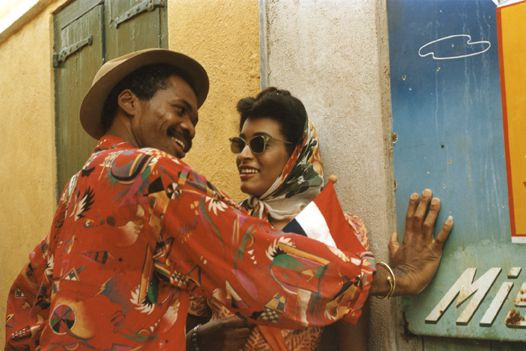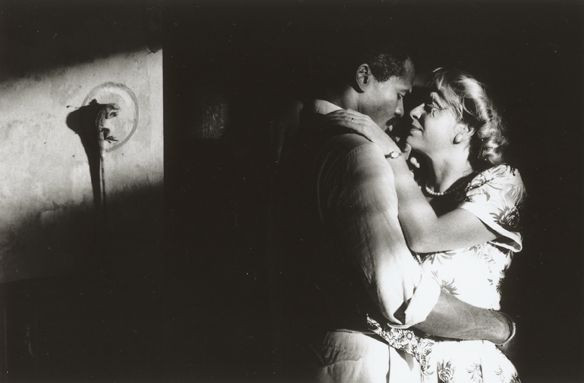Ava and Gabriel: An Exegesis
Public Program Felix de Rooy
Events — Jun 1, 2023
During the exhibition of Felix de Rooy — Apocalypse, DARKMATTER Collective will present Ava and Gabriel: An Exegesis, a daylong curated program of experimental and transmedial artistic activities based on Rooy’s movie Ava & Gabriel: A Love Story. It is a groundbreaking and prescient work that is arguably the artist’s magnus opus and a landmark in Caribbean cinema.
- Price
- Regular: 12 euros, reduced price: 3 euros
- Location
- Teijin Auditorium & Felix de Rooy
- Time
- Jun 1, 2023, 12 pm until 6 pm
- Main language
- English
- Admission
- Book here
Curatorial Statement
Ava & Gabriel: A Love Story is considered by many to be the magnum opus in artist Felix de Rooy’s cinematic oeuvre and a landmark in the history of Caribbean cinema. Released in 1990, this richly textured and wildly experimental work broke many boundaries and taboos at the time of its release – formally and thematically – and its prescience as a sociocultural text is undeniable as it foregrounds a range of issues that remain urgent to this day in the wider world as well as in the Caribbean region.
The film’s backdrop is the island of Curaçao, a Dutch Caribbean colony whose socioeconomic history is dominated by the trans-Atlantic slave trade. Like all post-slavery societies, Curaçao has evolved into a modern society bearing many of the social markings, habits and hierarchies that were entrenched during centuries of normalised enslavement.
As is dramatised in the film, the intersection of race, sex and unequal power relations over centuries of slavery has led to a mainstream culture in the island in which lighter complexions are privileged over darker ones. The abjection of blackness - the colour of the African slave - finds its many expressions in local understandings of social status, values and religious legitimacy. The effects of slavery, a system that brought enslaved Africans into constant contact with European colonisers, are also seen in the linguistic and cultural hybridity of Curaçaoan people - who typically speak Papiamentu, Spanish, English and Dutch - as well as in their facility for code-switching.
On the occasion of the Stedelijk Museum Amsterdam’s retrospective of the work of Felix de Rooy, The DARKMATTER Collective presents a daylong curated programme of transmedial artistic activities entitled Ava and Gabriel: An Exegesis. As our chosen title suggests, we intend to present to the public a wide-ranging artistic analysis and explication of the film’s text in order to highlight de Rooy’s bold and groundbreaking approaches both to cultural critique and art-making.
The rationale for this project is multifold. De Rooy can be viewed as a form of “dark matter” in the way that his art is somewhat obscure and even forgotten to the younger generations, even though he has been a pioneer in raising many of the artistic and social concerns that currently dominate the global conversation.
Secondly, Ava & Gabriel on its own can be viewed as both a biography of the artist and a mini-retrospective of his various preoccupations. Writ large, Ava and Gabriel: An Exegesis would provide audiences with a magnified perspective on how one canonical work can be emblematic of the whole of an oeuvre in terms of style, composition, technique, political and affective investments, setting and use of symbolism.
Program
Featured Artists: David van Delden, Durwin Lynch, Vernon Chatlein, Nash Caldera, Analemma, ABRA SEY BISING, Taneesha Sijmons, Ro Verwey and Papa Oyeyemi.
The program of activities for Ava and Gabriel: An Exegesis is referred to as chapters. The format of the program reflects the experimental nature of the event by entirely eschewing the conventional approach of using a Master of Ceremonies, host, panels and moderators to introduce and/or contextualise the material being presented. Instead, the audience will be allowed to experience each presentation in a visceral way while given the opportunity (before the event, during the breaks, and after the event) to engage in ‘self-education’ - delving into relevant background information related to each Chapter and the film as a whole - depending on their individual interests and responses to each presentation.

Program details
- 10.30 am – 6.00 pm
- Screening 'Ava & Gabriel: A Love Story'
- 12.00 pm – 12.30 pm
- Chapter 1 - Kuminsamentu: Willemstad Rap
Artists: David van Delden, Durwin Lynch & Vernon Chatlein - 1.00 pm – 1.45 pm
- Chapter 2 - Polyglossia: Island of Babel
Artist: Nash Caldera - 2.15 pm – 3.00 pm
- Chapter 3 - Syncretism: Obia Woman / Creole
Artists: Analemma - 3.30 – 4.15 pm
- Chapter 4 - Colonial Education: Mijn Zusje is Blond
Artists: ABRA SEY BISING - 4.45 – 5.15 pm
- Chapter 5 - Final: Abominable Acts
Artists: Taneesha Sijmons, Ro Verwey & Papa Oyeyemi
More info about the program
CHAPTER 1
KUMINSAMENTU: WILLEMSTAD RAP
Contributing artists: David van Delden, filmmaker, storyteller and tech entrepreneur, Durwin Lynch, researcher on Afro-Creole healing practices and Vernon Chatlein, percussionist and composer from Curaçao specialized in Afro-Caribbean, Latin Music and Jazz.
The first item on the programme combines experimental filmmaking and performance lecture for a dynamic overview and explication of the day's themes and concerns. Durwin Lynch, a researcher on Afro-Creole healing practices in Curaçao will have his voice and ideas fused with the stunning visuals of Curaçaoan filmmaker and storyteller David van Delden. Meanwhile, Curaçaoan composer and percussionist Vernon Chatlein will provide a live score for the presentation. An ode to Felix de Rooy, his film Ava and Gabriel: A Love Story, and to the island of Curaçao, this will serve as a fitting opening to the Exegesis.
CHAPTER 2
POLYGLOSSIA: ISLAND OF BABEL
Contributing artist: Nash Caldera, visual and performance artist.
The term 'Polyglossia' refers to the coexistence of multiple languages in one society, community or area. The Caribbean Island of Curaçao where de Rooy's film is set is a perfect example of this. As the film deftly illustrates, most Curaçaoans are fluent in Papiamentu (the native tongue), Spanish, Dutch and English. Other languages like Sranan Tongo, Antillean French Creole and French are also very common among the local population. Polyglossia: Island of Babel will be an semi-abstract performance by Curaçaoan visual and performance artist Najendra ‘Nash’ Caldera. This commissioned piece celebrates the 'Tower of Babel'-like linguistic plurality and code-switching dexterity of creolised people using Caldera’s own experimental use of different languages and transdisciplinary methodologies. Her work will build on the film's dramatisation of the “conflicted hybridity” inherent in creole identity and everyday language use and will bring a fresh contemporary perspective to this prescient filmic text.
CHAPTER 3
SYNCRETISM: OBIA WOMAN/CREOLE MADONNA
Contributing artist: Analemma, a decolonizing club dance ritual centering queer people of colour.
In this performance workshop led by Analemma, a group practising a decolonizing dance ritual centering queer people of colour, participants learn ways to employ African and Afro-creole spirituality as a means of dismantling the conscious and unconscious mental structures and anti-black ideologies that Christianity and other forms of established religion in the West have implanted as part of an ongoing colonial project. The demonization of black belief systems, ancestral connections, folk medicine, mysticism and magic are key currents in Felix de Rooy's landmark film, and this workshop acts as a counteracting force working against it. This will be a master class in metaphysics, community ethics, self care and decolonization of the mind through performative engagement with African beliefs - those that exist today on the continent and those that survived the Middle Passage and adapted to other circumstances in other localities.
CHAPTER 4
COLONIAL EDUCATION: MIJN ZUSJE IS BLOND
Contributing artist: ABRA SEY BISING, consisting of Ciro Goudsmit, movement and sound artist & Rachwill Breidel, musician and producer.
One of the most arresting and haunting scenes in the film Ava & Gabriel: A Love Story is in which a white Nun is teaching the Dutch language to a classroom full of Curaçaoan pupils. In the call-and-response style typical of traditional primary-level education in European colonies, the teacher urges the pupils to repeat the Dutch phrases after her. The dark satirical humour of de Rooy takes over the scene as we hear the classroom of black children chant in unison at the direction of their white teacher: "Mijn Zusje is Blond!" (My Sister is blond). This brief but poignant scene adds an ominous undertone to the film as the viewer is suddenly confronted with colonialism's brazen genocidal mission in the most innocent of spaces. This is one of the many grains from the film that will form the basis for Rachwill Breidel and Ciro Goudsmit's sound installation which they will perform live to the audience in the Stedelijk Museum's auditorium. This specially commissioned work will be an assemblage of evocative elements ripped from the musical score and provocative soundbites lifted from the dialogue that are then stitched together using the two artists' own electronic and hip-hop-infused beats and samples. This work is a sonic lecture on the many facets and tentacles of colonial domination, illustrating through sound the ways that this form of power has educated humanity to see itself as fundamentally differentiated, categorised and hierarchised.
CHAPTER 5
FINAL: ABOMINABLE ACTS
Contributing artists: Taneesha Sijmons, artist, erotic dancer, model, sensuality coach and pleasure activist & Ro Verwey, performer, maker, educator, coach, policy maker and activist
The final item on the programme is an experimental performance piece that ruminates on the violence of censorship while expanding the conceptual application of the term itself - from artworks to human bodies. Adapting the characters of Gabriel (the painter) and Ava (his model) to a new political context, this work transforms the audience into voyeurs as Gabriel, a non-binary pornographic artist, films, paints and makes love to the moving body of Ava, a pole-dancer. Acting as an intruder on this erotic encounter will be various bits of text, projected onto the stage and performers, that are extracted from recent anti-queer acts of parliament, bills and other pieces of legislation from countries like Nigeria, Ghana and Uganda. The piece calls urgent attention to the role played by the Evangelical Christian movement - and the European and North American governments that actively sponsor it - in the wave of violent anti-queer legislation that has swept through Africa and other parts of its diaspora, criminalising same-sex acts, same-sex marriage, queer allyships and advocates of LGBTQ+ rights, and by the same token, queer art and queer artists.
THEMES
The day of artistic activities that will form the complete Exegesis will follow five overlapping thematic currents excavated from the film: Creolisation, Colonialism, Artistic Freedom, Afro-Creole Spirituality and Love in a Hostile World.
MORE INFO ABOUT THE THEMES
Creolisation: Set on the island of Curaçao in the 1940s, the film dramatises the “conflicted hybridity” that is characteristic of a post-slavery creole society - the multi-layered mix and clash of various cultural elements that came into contact with each other in the colonial history of the Caribbean history: race, national origin, religion, language and cultural traditions, etc.
Colonialism: Colonial domination is a running theme throughout the film and de Rooy deftly exploits this through several poignant vignettes highlighting the oppositions and tensions between Dutch imperial power and the colonial subjects on the tiny island. This is presented through scenes involving colorism (the hierarchies that privilege lighter- skinned over darker skinned colonial subjects), colonial education and its discontents and the problem of race and representation.
Artistic freedom: De Rooy’s protagonist Gabriel is more or less an avatar of the artist himself and one of the key problems he confronts in the plot is that of censorship. The spectre of the censor still looms large over the contemporary artist in today’s world, even with the global advancement of democratic ideals. How autonomous is art in today’s world when the artist still labours under the pressures brought about by moral authority, state funding, consumer demand and corporate sponsorship?
Afro-creole Spirituality: In Ava & Gabriel: A Love Story and elsewhere in his work, Felix de Rooy regularly taps into the kaleidoscopic world of Afro-creole spirituality and sorcery to show how colonial and post-colonial island life is a tapestry made of real and imagined spaces, woven from a collective memory of Africa that persists among the descendants of enslaved peoples. This spirituality is a crucial form of resistance to colonial power and a metaphysical mode of transcending the brutal realities of economic and cultural subjugation.
Love in a hostile world: The film is first and foremost a love story, and in it, the love between characters moves across several boundaries and conquers numerous obstacles. The eponymous star-crossed lovers must overcome the many prejudices and hostilities that are prevalent in a small island society and that threaten their impending union. Classism, colorism and xenophobia are chief among these, however, one such obstacle that makes its now celebrated appearance for the first time in the history of Caribbean cinema is homophobia. De Rooy bravely presents queer characters and queer love to a mainstream audience – an artistic feat that is still quite risky for any contemporary filmmaker working in a region where colonial-era anti-gay laws still exist.

ABOUT FELIX DE ROOY – APOCALYPSE
The exhibition Apocalypse provides an overviewof the extensive experimental and multidisciplinary oeuvre of Felix de Rooy (Curaçao, 1952). It is a retrospective that pulls together all the domains present in his artistic practice and spans five decades of his career. De Rooy has long been a pioneer in addressing issues that would later become mainstream, such as the ongoing legacy of colonialism and the meaning of Afro-Caribbean and queer identities in art. The exhibition title refers to the symbolic end of the world and the promise of a new dawn, a recurring theme in the artist’s work.
During this day which is put together by DARKMATTER the museum delves deeper into his Gouden Kalf award winning film Ava & Gabriel. This magnified perspective will show how one canonical work can be emblematic of the whole of an oeuvre in terms of style, composition, technique, political and affective investments, setting and use of symbolism.

